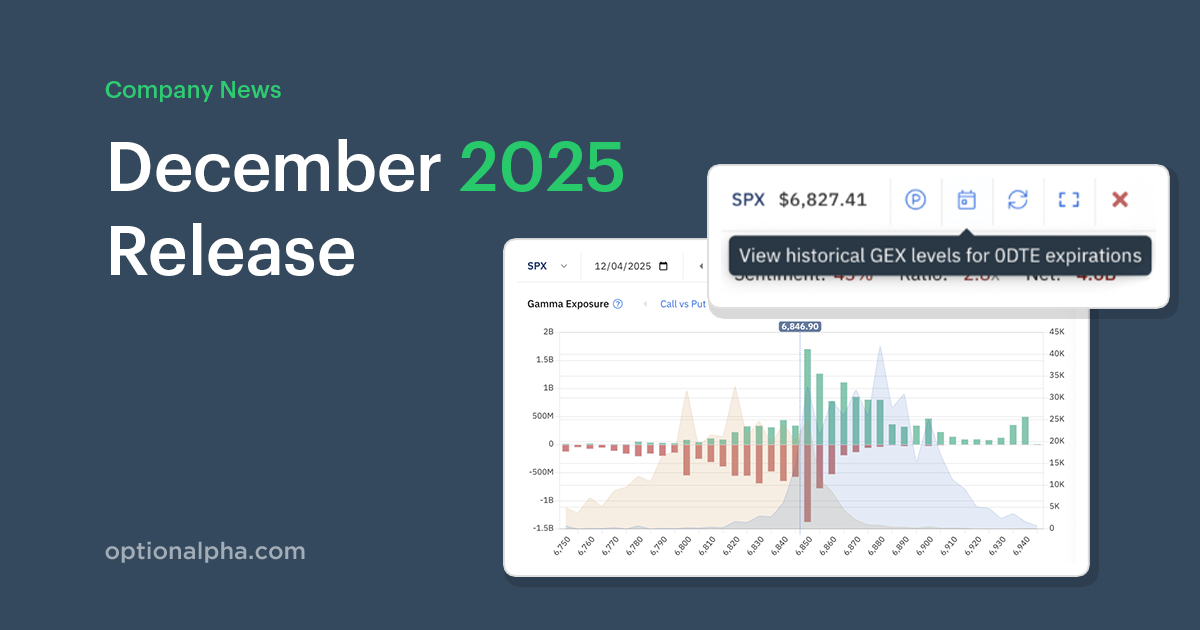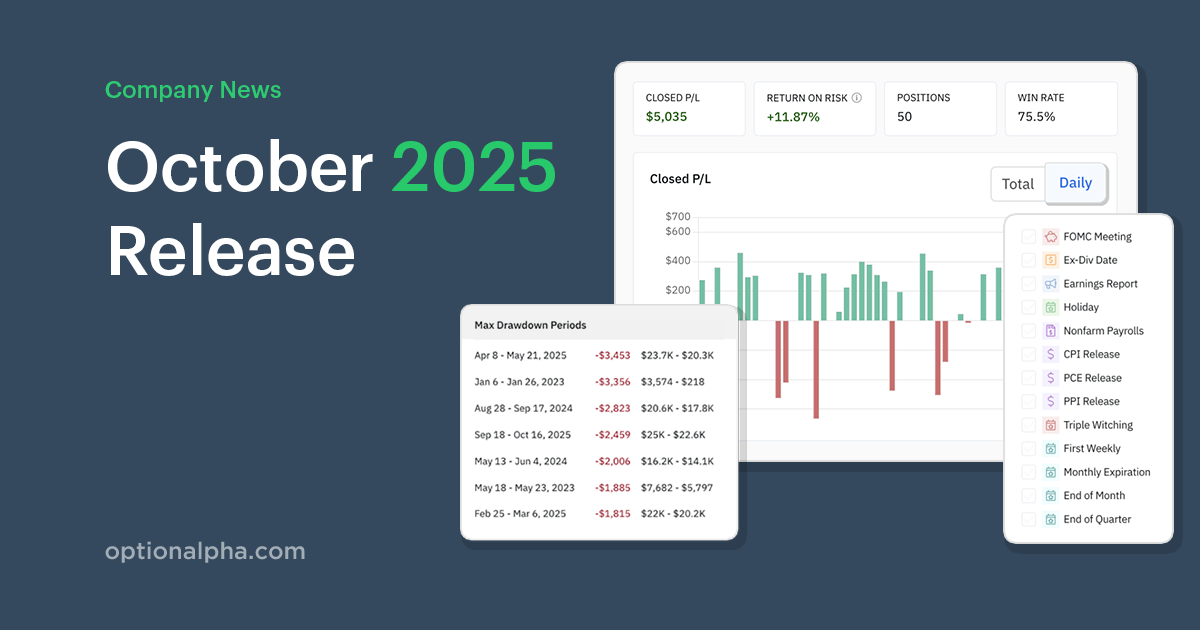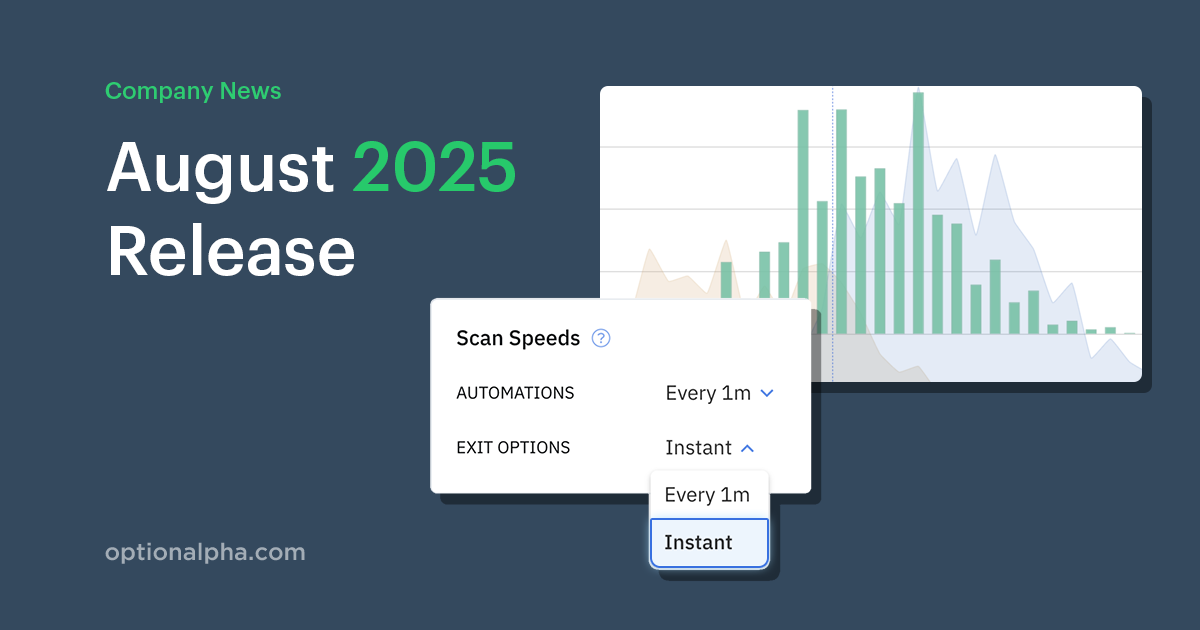Put credit spreads are near the top of every option seller’s list of go-to strategies. The simplicity of the strategy (selling a vertical spread) coupled with the ability to trade directionally make put credit spreads a crowd favorite.
Put credit spreads (bull put spreads) consist of selling a put option and purchasing a put option at a lower price. This creates a risk-defined spread that takes advantage of an increase in price in the underlying asset before expiration.
Quick example: sell a $50 put option and buy a $45 put option to create a $5-wide put credit spread. If this results in a $1.00 credit, the maximum profit potential is $100 ($1.00 credit times 100 contracts) if the stock closes above $50 at expiration, and the maximum loss is $400 if the stock closes below $45 at expiration.

Using Option Alpha’s Backtester, we explored the historical performance of put credit spreads on SPY to help you determine the entry and exit criteria that best fit your trading objectives.
Setting up the SPY Put Credit Spread Backtest
The core of any systematic trading strategy is a full understanding of its historical performance. While past success or failure may not translate into the future, historical testing is essential to understanding how strategies will perform with all else held equal. Testing can show you how to tweak strategy elements for greater success.
We tested four put credit spread variations over five years to gain a broad perspective of how adjusting the various strategy components impacts the historical performance.
Each scenario used the same strike selection criteria: 0.30 delta for the short contract and 0.10 delta for the long contract. We compared 5% and 10% capital allocations for each variation, as well as testing combinations of profit targets, stop-losses, and timeframes for position rolling.
Needless to say, we backtested a lot of scenarios!
The first backtest sequentially opened bull put spreads on SPY:
- 30 days to expiration
- Hold the position to expiration
- Only one position active at any time
- No profit targets or stop-loss levels
The second test had the same basic parameters but added:
- A 50% profit target
- A 25% stop loss
- Position closing at 15 days to expiration
The third test held everything constant from the second test, but:
- Increased the stop loss to 50%, allowing a wider trading range before automatic closing
Finally, the fourth test used the same parameters as the second test but:
- Increased the profit target to 75%
Each of the four variations was tested with both 5% and 10% position allocations for a $100,000 account for a total of eight backtests studied.
Backtest Results
"Small" decisions like profit targets or DTE exit criteria can seem insignificant compared to what underlying or strategy to trade. However, the results shown below clearly demonstrate that optimizing these less visible trade elements has a tangible impact on overall profitability.
Backtest One

At the most basic level, allocating 10% of the portfolio to this strategy produced remarkably better results than allocating 5%, netting a return on capital (RoC) of 39% and 16%, respectively.
It’s logical that a larger position size creates a higher RoC. However, once we standardize by the position size and calculate a return on risk (RoR), we found that the 5% position size had a slightly better return on risk (280% vs 272%).
Despite the higher RoR, the 5% position size has a lower Sharpe ratio than the 10% allocation (0.56 vs 0.62). As a reminder, the Sharpe ratio is the return divided by standard deviation. So, a lower variability creates a smaller denominator and a greater overall divided result.
Overall, this was a profitable strategy, with a 93% win rate and no consecutive losses throughout the five-year testing period. The image below shows the full results produced by the Option Alpha Backtester for the 5% allocation strategy.

Backtest Two

In this and the following test, we focused our attention on the 10% allocation. Introducing the three new trade components (profit target, stop-loss, contract rolling) had a substantial impact on overall strategy performance. These additions dramatically lowered volatility, shrinking the max loss for the 10% allocation from $12,000 to $2,000.
Given this lower variability, the second test had a notably better Sharpe ratio (0.62 for the first test and 0.77 for the second test).
Both the RoC and RoR are lower for this adjusted strategy. Because of the additional exit criteria, the strategy opened a total of 295 positions compared to 133 in the first test. Since these trades are executed sequentially, closing positions 15 days to expiry instead of holding until expiration, led to more closed positions. More closed positions leads to a higher total position count.
These backtests do not account for brokerage commissions because commissions can vary so much from broker to broker.
Overall, adding these exit criteria (profit target, stop-loss, rolling contracts) creates a smoother ride, but the trader loses out on some potential upside. In mathematical terms, Backtest Two has a more “normal” distribution than Backtest One’s wider dispersion of trade outcomes, creating a more tail-skewed distribution (i.e., "fat tails" or skew).

Backtest Three

The previous test had a 25% stop-loss. By exiting a position at a 25% loss, the trader lost virtually any opportunity for recovery and potential profit. In this test, we increased the stop-loss to 50%, creating more downside risk but also more opportunity for positions to recover.
As expected, this strategy adjustment increased the average position downside. However, there was not a corresponding increase in average position profitability.
Interestingly, this means that the original 25% stop-loss parameter was not constraining our chances for profitability, but instead almost exclusively protecting large downside losses.
Since the stop-loss was not constraining profitability, we adjusted our test to consider whether different position rolling criteria could improve our put credit spread strategy. We found that only one position out of 296 even reached 15 DTE and rolled into the next month.
That led us to test whether increasing the profit target could further optimize the strategy.
Backtest Four

Increasing the profit target parameter to 75% improved the RoR by 9% compared to the second backtest examined. However, by increasing the profit target, we also gave open positions more time to fall into a less profitable range.
For example, if a position was at a 51% profit, Backtest Two would have closed the position. This would be great if the position was later challenged but would leave money on the table if the underlying continued to climb.
The reverse is true for Backtest Four. Not closing at 50% leaves more room for profit but also puts the trader at risk of closing the position for less than a 50% profit.
While the profit target increase did cause the average loss to increase from $900 to $975, an increased profit factor (1.34 vs 1.26) and Sharpe ratio (0.83 vs 0.77) demonstrated efficiency and further strategy optimization.

Better Results with Automation
In the end, Backtest One had the highest profitability and win rate, but traders had to stomach extreme volatility to achieve the return. The strategy won often (93%), but its occasional losses were large. More flexibility in position management could give the trader the best of Backtests One and Four, offering a high win rate along with greater downside protection.
All these results were generated using Option Alpha’s Backtester, available with the new automated trading platform.
Can automation offer opportunities to improve these results? Using Option Alpha’s autotrading platform, traders can create strategies with greater complexity than demonstrated in these tests and have confidence that the bots will manage positions according to the trader’s instructions.
Remember the issue with Backtest Four’s 75% profit target? Raising the profit target optimized upside capture but also gave the position more time to fall into less profitability. Option Alpha’s SmartStops can solve the problem.
SmartStops are a more advanced and intuitive version of trailing stops. SmartStops allow a trader to set a “hurdle” that the position must pass (say 50% profit target) before a trailing stop is applied (say 10%).
For example, we could set our hurdle to the profit target of 50% from Backtest Two, then set a 10% trail. This would allow the possibility of profit above 50% while also limiting the possibility of a large reversal.
The major difference between Backtest One and Backtest Four was the higher profit target. With SmartStops, instead of having to select one extreme, traders have the opportunity for higher profits without the risk of losing the gains.
SmartStops are not static, and traders can combine multiple types into a single automation. For example, a trader could have a SmartStop with a 50% profit target and 10% trailer, a 90% profit target to close positions, and a 25% static stop loss at the same time. Talk about flexibility!
This level of customization eliminates the problems we found throughout our backtests, giving traders comfort in their positions’ profitability while also maintaining a possibility for more upside.
Unless you sit in front of the screen for the whole trading day, this level of optimization is only possible with bots, informed by you, with no coding required. SmartStops are just one way to optimize these strategies.




.png)









